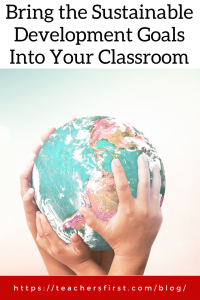Critical thinking, social-emotional learning, culturally responsive teaching, authentic learning—these are a few of the latest terms found in many discussions of education and teaching. It might seem daunting to address all of them, but some issues offer the opportunity to embrace these concepts by providing lessons with a larger frame of reference. One such frame of reference is the incorporation of the Sustainable Development Goals (SDGs).
What are the SDGs?
- The 17 Sustainable Development Goals were adopted by United Nations members in 2013 and share an outline for obtaining peace and prosperity throughout the globe. Goals address poverty, equity, and climate action, but the four key components are people, planet, prosperity, peace and partnership.
Why should I teach the SDGs?
Teaching the SDGs…
- Meets social studies standards as students learn to understand the world from a global perspective.
- Incorporates social-emotional learning standards to help students develop empathy and compassion.
- Raises awareness of the need for students to build a more sustainable earth that is part of their future.
- Provides a platform for students to use research, critical thinking skills, and information about real-world problems within any current curriculum.
Where can I find resources for learning about and teaching the SDGs?
- World’s Largest Lesson (reviewed here) – Free resources include videos, lessons, games, quizzes, and printable books. You can sort by language (Azerbaijani through Yoruba), theme, age (from two through adult), SDG, or length of activity.
- Flipgrid (reviewed here) – Girl Rising is a Flipgrid partner who uses storytelling to raise awareness so all girls can be valued and educated. Their library includes topics for goals four and five that have a link to videos and articles. After viewing the information, students use evidence from the text and videos to respond to the included prompt.
- Wakelet (reviewed here) – Search Wakelet to find collections with ideas for teaching the SDGs. This collection includes articles, videos, and blogs related to the SDGs, while this collection shares an eleven-week student project activity based upon SDG #15 Life on Land. Student projects include poems, music, and infographics. For even more ideas, take a look at the RiseUp4SDGs International Project collection, which provides project and teaching resources separated by each SDG goal.
How can I use the SDGs to engage, enhance, and extend learning?
- Threadit (reviewed here) – Create a video thread sharing student ideas for addressing issues discussed in the SDGs. Use one of the templates (such as the pitch template) to provide an outline for sharing student solutions to problems addressed in any of the SDGs.
- Circly (reviewed here) – Circly is a colorful organization app. Use Circly to help students visualize components of each of the SDGs. For example, break problems and solutions into smaller pieces like local, state, national, and international issues.
- IdeaBoardz (reviewed here) – Use IdeaBoardz to create organized lists using the provided format templates. The six thinking hats template guides users through considering different options by beginning with a column for adding a process, then considering facts, feelings, creativity, benefits, and cautions. Use this option to help students explore different ways to consider their ideas for addressing SDGs.
- EdPuzzle (reviewed here) – Edit videos, add voiceovers and questions, insert notes, then share interactive videos to engage students in learning about the SDGs.
- Canva Comic Strip Templates (reviewed here) – Have students share their ideas and solutions using comic strips. Choose from the many templates to create digital stories that tell of an individual or global accomplishment. Tip: identify free templates by hovering your cursor over each template block and looking for “free” in the bottom right-hand corner.
- Book Creator (reviewed here) – Use students’ comic strips, images, or PDFs to create digital books based on the SDGs. Find additional suggestions for facilitating cultural dialogue in this blog written by Michael Hernandez for Book Creator.
- Participate in TeachersFirst Across the World Once a Week (XW1W) Global Collaboration for Cross-Cultural Understanding (shared here) – Each week, classrooms respond to prompts based on the SDGs to share ideas and perspectives from their school on social media using #XW1W. Engage your students by including their responses and comparing them to those of their peers across the globe.
Lessons based on the SDGs provide many learning opportunities across different content areas. Consider using these resources as part of science lessons, social studies content, and within your language arts program. In addition, work with music, art, and physical education instructors to develop activities that provide cross-curricular content.
Have you integrated the SDGs into your classroom lessons? Perhaps you have suggestions to share with our readers! If so, consider sharing your ideas in the comments as we learn together.


